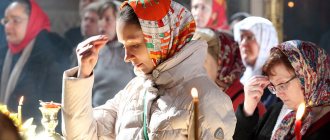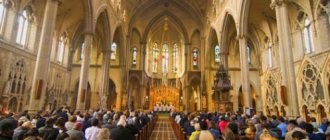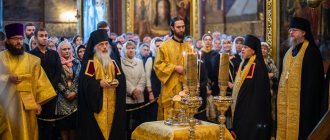The tradition of making the sign of the cross goes back so far into ancient times that it is impossible to trace when it originated. Research by P.P. Soykin, author of the Orthodox Theological Encyclopedia, allow us to say that the ritual first appeared in apostolic times.
According to the records of one of the first theologians, Tertullian, who lived in 160-220, the symbol of the cross was used by his contemporaries everywhere: before and after leaving home, before meals, business negotiations, when saying goodbye or meeting.
Church books mention John the Baptist (John the Baptist) as one of the first to use the sign of the cross. In fact, one can only guess where the tradition came from, but the fact is undeniable - the sign of the cross is an integral part of Christianity and one of its most important rituals. But why do Orthodox Christians cross themselves from right to left, and Catholics vice versa? Let's look into this issue.
Orthodox rules of baptism
There are no church dogmas on this topic. The traditional version says that Orthodox people are theocentric, that is, they perceive God as the fundamental principle of everything that happens in the world. Symbolically, moving the hand from right to left means that a person calls on God’s grace. The cross is a request to save and preserve from troubles, illnesses, and evil spirits.
Also in the Christian tradition, the right side is usually identified with the divine, and the left with the demonic. Therefore, when Orthodox Christians cross themselves from right to left, they show the victory of the bright angelic forces over the darkness of hell. At the same time, 3 connected fingers symbolize the Holy Trinity, and two pressed to the palm symbolize the human and divine essence of Jesus Christ.
Interesting: Why is it easy to evaporate salt, but difficult to evaporate sugar?
How to correctly perform this rite at the Baptism of the Lord?
The Epiphany of the Lord is a great event that is celebrated annually on January 19.
Believers prepare for this day in advance. It is considered real blasphemy to drink alcohol during this holiday and jump into an ice hole with a running start, without following the rules established for this procedure. You can plunge into the ice water only after it has been consecrated, but before that you must attend the morning service in the temple. Epiphany is a holy holiday. The first immersions in water were carried out by John the Baptist, who baptized Jesus Christ. For faith in his Savior, this prophet lost his head. The ritual of rebaptism on this day is no different from the same action at any other time. You just need to do this before diving into the water, when the person is still on the ground.
From left to right or vice versa How to be baptized correctly by an Orthodox Christian
- First, we place our fingers on our foreheads, asking the Lord to sanctify our mind.
- We place our fingers on our stomach in the solar plexus area and ask God to prolong the days of our lives.
- We place our fingers on the right shoulder.
- We place our fingers on the left shoulder.
In this way, we seem to draw a cross on ourselves, agreeing to accept the will of God and follow Christ. To consolidate their devotion to God during services, people also bow to the ground and bow to the ground. When making a bow, people bow at the waist, and during the earthly bow they kneel and touch the floor with their foreheads.
Old Believers, on the contrary, fold their index and middle fingers, and press the rest to the palm. At the same time, the essence of the sign remains the same.
Catholics make the sign of the cross using their entire palm and do it from left to right, not from right to left. The entire palm is used as a symbol of the wounds on the body of Jesus, there were five of them - two on the legs, two on the arms and one from the copy. In Orthodoxy it is believed that this is not a dogmatic, but a ritual image of the cross.
Orthodox family: Russian traditions
When to be baptized
The Venerable Ephraim the Syrian (306-373) answers the question “when should one be baptized” fully and figuratively:
“Instead of a shield, protect yourself with an honest Cross, imprint it on your members and heart. And not only with your hand put the sign of the cross on yourself, but also in your thoughts, imprint with it every activity you do, and your entrance, and your departure at every time, and your sitting, and your rising, and your bed, and any service... For this is very strong weapons, and no one can ever harm you if you are protected by them” (Collected Works, volume 2).
The sign of the cross accompanies the Orthodox Christian in every activity. At the beginning of prayer and at the end, when blessing food and giving thanks after a meal, before leaving the house, before going to bed...
As Tertullian (an early Christian writer and theologian) wrote at the beginning of the 3rd century: “We protect our foreheads with the sign of the cross in all circumstances of life: entering and leaving the house, dressing, lighting lamps, going to bed, sitting down for any activity.” (“About the Warrior’s Crown”).
But it is important not only to pay external attention to how Orthodox Christians are baptized. The main thing is to make the sign of the cross with fear and reverence, realizing the holiness and greatness of this gesture.
“When you seal yourself with the sign of the cross, imagine in your thoughts the whole meaning of the cross, and you will quench anger and all other passions” (St. John Chrysostom).
When to be baptized during prayer in church
Church services occupy a special place in the life of a Christian. During the service, there is a certain order for making a prayer gesture. This applies to bows, which should end the sign of the cross.
Bowing indicates our humility before God, our readiness to serve His glory and follow His will. There are two types of bows: waist and earth. From their name it is not difficult to guess how to perform them correctly. When bowing from the waist, we bend our back at the waist so that our hand touches the floor. When bowing to the ground, our head bows before the Lord to the very ground, for which we kneel.
When to be baptized with bows from the waist
1) Honoring and respecting the temple as the house of the Lord, before entering and leaving it, you need to cross yourself three times with a bow from the waist.
2) One of the most frequent chants during worship is the exclamation “Lord, have mercy,” that is, “Give, Lord.”
3) Before starting to read the Creed, the Apostle, the Gospel, and the prayer Our Father. After completing the reading of the Gospel, it is also necessary to bow.
4) During the prayer “Holy God, Holy Mighty, Holy Immortal, have mercy on us.”
5) Prompts for making a bow are such exclamations as “let us bow,” “let us fall,” “Alleluia,” “Come, let us worship,” “Glory to Thee, Christ God.”
6) With the priest blessing those praying with the Cross, the Chalice with the Holy Gifts, and the Gospel.
Inquisition
To the question of who the Catholics of the medieval period were, you can get an idea by familiarizing yourself with the activities of such a church body as the Inquisition. It was a judicial institution of the Catholic Church, which was intended to combat heresy and heretics. In the 12th century, Catholicism faced the growth of various opposition movements in Europe. One of the main ones was Albigensianism (Cathars). The popes assigned the responsibility of fighting them to the bishops. They were supposed to identify heretics, judge them, and hand them over to secular authorities for execution. The ultimate punishment was burning at the stake. But the episcopal activity was not very effective. Therefore, Pope Gregory IX created a special church body to investigate the crimes of heretics - the Inquisition. Initially directed against the Cathars, it soon turned against all heretical movements, as well as witches, sorcerers, blasphemers, infidels, etc.
Blessing of Anointing (Unction)
Unction is performed by one or more priests and consists of prayers and anointing of the forehead and palms of the unction with consecrated oil. There are no special differences regarding this sacrament. However, in Orthodox churches this ritual is performed not only with the dying, but also with people whose health has deteriorated.
“As for the consecration of oil, or unction, the Catholic Church still maintains a tradition associated with the sacrament that is performed before death. That is, unction is performed on elderly people who are on the threshold of earthly life. In the Orthodox tradition there is no such judgment; any adult can participate in unction, but not an infant. In our tradition, unction takes place during Great Lent and Peter’s Lent,” says Posternak.
How to prepare for the Unction? More details
Why should a child be baptized?
But for a true Christian, baptism is the natural joining of a child into the life of the Christian community and a gesture of gratitude to God for the trust to accept and raise a new person. —Through baptism, the stain of original sin—the sin of Adam and Eve—is washed away from the child.
Interesting materials:
Who plays Lilya in Sashatan? Who plays Mura in the TV series Sea Devils? Who plays Ravshan in our Rush? Who plays the role of Baba Nina in Blind? Who plays the role of Yusuf in Zuleikha? Who plays the role of Rita in the series Interns? Who plays the role of Zuleikha's mother-in-law? Who plays the roles of Ravshan and Dzhamshut? Who plays old Captain America? Who plays the tiger in Sea Devils?
Why is it correct to cross from right to left?
Among the Orthodox, the sign of the cross with three fingers is performed from right to left, which is explained as follows: on the right shoulder of a Christian is the place of the saved, on the left is the place of the lost. In other words, the right side symbolizes heaven, where angels and saved souls live, and the left side symbolizes hell, where demons reign and where all sinners go. Thus, by first raising his palm to his right shoulder, the Christian asks the Lord to count him among the saved. Afterwards, transferring the three-fingered finger to his left shoulder, he prays to God for deliverance from the fate of the perishing. All this implies a gesture of some kind of protection during prayer or worship and at the same time turning to the Lord Jesus Christ with repentance.
Why do Christians get baptized?
The sign of the cross is a special prayer hand gesture with which Christians depict a cross on themselves. This is not just a ritual action or a religious injunction. The cross is the main symbol and spiritual weapon for believers and has a deep meaning. Therefore, it is important to know how Orthodox Christians are baptized.
Orthodox sign of the cross
“But what is the Cross? In a material sense, it is a symbol that we possess. But this symbol cannot be created. What matters is the power that lies in this symbol. With the help of this power, God the Word united those who disagreed and <…> returned our rebellious nature, subject to decay, to balance. He abolished death and the devil, opened the entrance to paradise for people, so that they could return to where they left, could enter there <...> where all the Divine vows are (schemamonk Joseph of Vatopedi).
The meaning of the sign of the cross
Orthodox Christians should not condemn those who do not know how to be baptized correctly, because the grace and love of the Lord do not depend on how we make the sign of the cross (although this should be done in accordance with the fundamentals of the faith). If a person accidentally crosses himself from left to right, but at the same time with his soul he has accepted the way of the cross of Christ and agreed to follow Him, this is not considered a sin. After all, the essence of the sign of the cross is to demonstrate in a visible way what is in a person’s soul - faith and love for Christ.
Among believers of the Orthodox tradition, there is a widespread belief that it is incorrect to make a godfather from left to right.
It is believed that the hand depicting the cross should first touch the right shoulder and then the left, which symbolizes the traditional opposition for Orthodoxy (and Christianity in general) between the right side as the abode of the saved and the left as the abode of the perishing (for more details - Matt., 25, 31-46 ). Thus, the Orthodox tradition believes that by raising his hand to his right and then to his left shoulder, the believer prays to be included in the fate of the saved and to be delivered from the share of the perishing.
In general, in everyday life, it is customary for superstitious or religious people to highlight the right side as purer than the left. Or even correlate good with the right side of a person, and evil with the left. Therefore, the opinion expressed above from the standpoint of religion seems quite logical.
Orthodoxy in Armenia
According to legend, the appearance of Christianity in Armenia dates back to the 1st century AD. e. They say that at that moment the apostles of Jesus Bartholomew and Thaddeus were preaching on the territory of the state. They are considered to be the founders of the Armenian Apostolic Church. The documents contain the date 301, when King Trdat III, by his decree, proclaimed Christianity as the state religion. It was then that Armenia became the first Christian country in the world.
Why are Armenians Orthodox? According to the latest censuses, it is noted that:
- 92.6% of the population belongs to the Armenian Apostolic Church,
- Armenian Evangelical Church – 1%,
- Armenian Catholic Church – 0.5%,
- Jehovah's Witnesses – 0.3%,
- Orthodox – 0.25%,
- Molokans – 0.1%,
- Other beliefs – 0.26%.
The best article for you, go to: How to get to Father Blasius at the Pafnutiev-Borovsky Monastery
Many clergy note that for a long time there has been no common church understanding between our churches, but this does not interfere with good neighborly relations.
WHY DO THE ORTHODOX BE BAPTIZED FROM RIGHT TO LEFT, AND CATHOLICS FROM LEFT TO RIGHT?
Orthodox and Catholics understand the essence of the sign of the cross differently.
Pius V in prayer. He pointed out: “Blessing himself. makes a cross from forehead to chest and from left shoulder to right"
Catholics were long allowed to be baptized in either of these two ways until Pope Pius V ordered them to do so from left to right and no other way in 1570. With such a movement of the hand, the sign of the cross, according to Christian symbolism, is considered to come from a person who turns to God. And when the hand moves from right to left, it comes from God, who blesses a person. It is no coincidence that both Orthodox and Catholic priests cross those around them from left to right (looking from themselves). For someone standing opposite the priest, it is like a blessing gesture from right to left.
Catholics usually cross themselves with all five fingers as a sign of the “sores on the body of the Lord Jesus Christ” - two on the hands, two on the feet, one from a spear.
In addition, moving the hand from left to right means moving from sin to salvation, since the left side in Christianity is associated with the devil, and the right with the divine.
In Orthodoxy, after Nikon’s reform, three fingers were adopted : three fingers folded together (symbolism of the Trinity), two fingers pressed to the palm (the two natures of Christ - divine and human). At the same time, the sign of the cross from right to left is interpreted as the victory of the divine over the devilish.
Historical excursion
Photo: Pravoslavie.ru
As Vasily the Great noted, the tradition of baptism became one of the traditions received by believers from the apostles. Moreover, it reached believers through custom, and not Holy Scripture. In all the places where Christ's disciples appeared, preaching his teachings, their followers began to be baptized after them.
At the same time, initially, different territories developed their own customs of making the sign of the cross. For example, on the territory of modern Western Europe with the entire palm, and on the African continent with only one finger (thumb or index finger, emphasizing that they recognize only one and only Lord).
The tradition of baptism in different ways between representatives of Orthodoxy and Catholicism took shape in the 11th century. It was directly connected with the church schism that occurred then. Since then, services, the appearance of religious buildings, the vestments of priests, and other traditions and rituals have become different. What remained constant was the commitment to Jesus. Despite individual approaches to conducting services, the Eucharistic canons are preserved.
In Christian customs, the tradition of using the sign of the finger has become established. The Orthodox used three fingers for this, which symbolize the trinity of God. Place your thumb, middle and index fingers together. The remaining two remain clenched into a fist. They also have symbolic meaning. They personify the fact that Christ, once on earth, was God and man.
Why do Catholics cross themselves from left to right, with two fingers or with the palm of their hand?
To answer the question, perhaps let’s go a little deeper into history:
- In ancient times, left and right most often carried associations regarding different kinds of gods who were on different sides.
- If we talk about Christianity, then the understanding of left and right is slightly different. Left and right are something completely different, something that has clearly opposite meanings. For example, as the struggle between good and evil, light and darkness, sinful and righteous. In Christianity, it is generally accepted that the right side is the territory of God, and the left is the territory of Evil.
- Another fact is that the Orthodox make the cross from the right shoulder to the left, but when they baptize someone, they do it in reverse. In any of these cases, initially the hand of the one who baptizes is on the right side. Why is that? The sign of the cross, which is carried out from left to right, means something coming from man to God, but from right to left - just the opposite, from God to man.
- Catholics, regardless of whether they baptize themselves or someone else, always do it only from left to right.
- In both the first and second cases, believers turn to God, but they attach different meanings to their appeal and communication with him.
- That is, the question: “Why do Catholics cross themselves from left to right?” can be considered closed. They are baptized in this way, because by applying the sign of the cross it is important for them to communicate with Christ, and they themselves cry out to him. This is exactly the meaning that is put into this action.
- It would also not be amiss to say that moving the hand from left to right can mean the path from darkness to light, from evil to good, from hatred of the world, from sin to repentance.
- Movement from right to left can be interpreted as victory over everything sinful, in particular the Devil. Since ancient times, it has been generally accepted that the unclean one “sits” on our left side. Therefore, such movements from right to left indicate the neutralization of evil force.
Scheme for applying the sign of the cross
Now a few words about why Catholics cross themselves with two fingers or with the whole palm:
ad6
- As mentioned earlier, Catholics do not have one correct option for folding their fingers or hands when crossing themselves. This is why you can sometimes see the sign of the cross applied with two fingers, and even with the entire palm.
- When Catholics cross themselves with two fingers, they once again confirm that they believe in the dual essence of Christ. That is, they realize and acknowledge the fact that Christ had both divine and human principles in himself.
- The open palm symbolizes the wounds of Christ. To be more precise, it is not the palm itself, but the fingers of the hand, which with this option of drawing a cross are in a straightened position.
Is it possible to be baptized in a public place?
There is no clear answer to this question.
Some Orthodox Christians believe that this should not be done in public, while others, on the contrary, do not hesitate to perform the ritual of rebaptism whenever they want. But God looks at the human heart and knows the thoughts of his creation. We need to remember this. Therefore, if a person is baptized in a public place simply to show his righteousness and piety, then he cannot avoid God’s punishment. If, for example, he is praying silently and he has a strong desire to cross himself as a sign that the prayer is over, he should not suppress this urge. The Holy Spirit is drawn to this. A Christian should not be ashamed of his faith; on the contrary, he should tell everyone about how good God is and what miracles He works in the lives of ordinary people who believe in Him. The ritual of rebaptism must be performed correctly in any place - even in the subway, even in a store. You also need to be baptized correctly in a cemetery. Namely, three times before entering his territory and three times after visiting him. Why is this being done? It is believed that the procedure of rebaptism in a cemetery “asks” God for the deceased person to hear everything that the person who visited him will tell him. This is a request for hearing.
You also need to be baptized when you drive past a Church or Temple. This is how a person shows his faith and shows respect for the ministers. Some believers believe that rebaptism must be performed at a crossroads because it is a special place. But it is special more for people who practice black magic. The priests do not say that believers should perform such a ritual at the crossroads of two roads.
We have different crosses
The first external difference between Catholic and Orthodox symbols concerns the image of the cross and crucifixion. If in the early Christian tradition there were 16 types of cross shapes, today a four-sided cross is traditionally associated with Catholicism, and an eight-pointed or six-pointed cross with Orthodoxy.
The words on the sign on the crosses are the same, only the languages in which the inscription “Jesus of Nazareth, King of the Jews” is written are different. In Catholicism it is Latin: INRI. Some Eastern churches use the Greek abbreviation INBI from the Greek text Ἰησοῦς ὁ Ναζωραῖος ὁ Bασιλεὺς τῶν Ἰουδαίων.
The Romanian Orthodox Church uses the Latin version, and in the Russian and Church Slavonic versions the abbreviation looks like I.Н.Ц.I.
It is interesting that this spelling was approved in Russia only after Nikon’s reform; before that, “Tsar of Glory” was often written on the tablet. This spelling was preserved by the Old Believers.
The number of nails often also differs on Orthodox and Catholic crucifixes. Catholics have three, Orthodox have four.
The most fundamental difference between the symbolism of the cross in the two churches is that on the Catholic cross Christ is depicted in an extremely naturalistic way, with wounds and blood, wearing a crown of thorns, with his arms sagging under the weight of his body, while on the Orthodox crucifix there are no naturalistic traces of the suffering of Christ, the image of the Savior shows the victory of life over death, the Spirit over the body.











